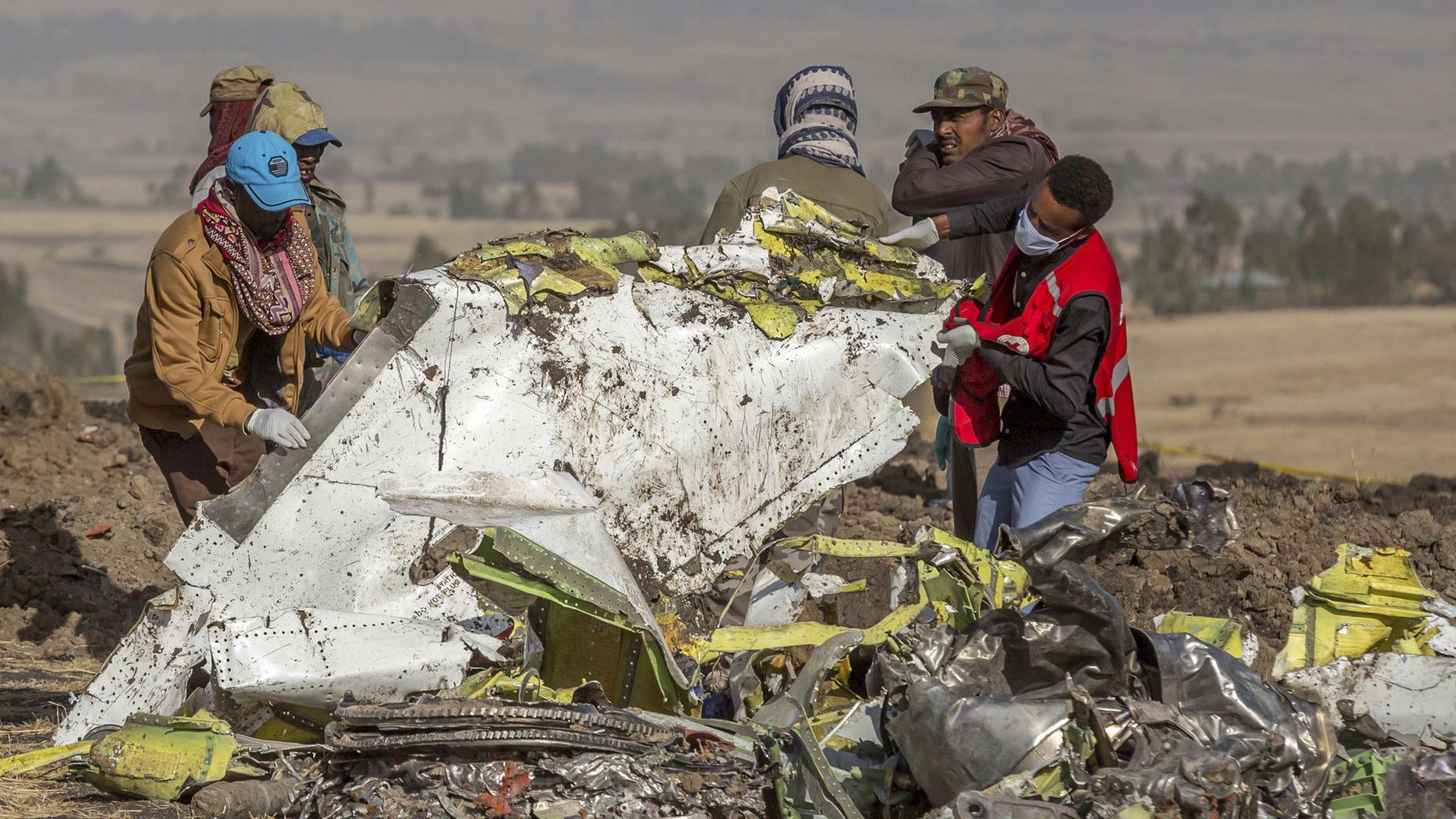In those same months, the Federal Aviation Administration was making its final revision to a 53-page report that would make up the backbone of Max 8 training guidelines for pilots across the United States and in almost every other country around the world.
It did not once mention the anti-stall system, according to a copy reviewed by The Post.
In fact, the FAA report suggested pilots would experience nothing surprising in the cockpit of the new Max 8. In a section where FAA test pilots are supposed to list “unique handling or performance characteristics” of new planes, they remarked that there were none: “no specific flight characteristics,” the report read.
Questions about pilot training requirements and the plane’s new technology are at the center of a roiling debate following the crashes of two 737 Max 8s in the past five months. Aviation authorities have said there were similarities between the flight paths of the two planes, each of which crashed shortly after takeoff, and the FAA grounded Max 8s this week. Indications that the crashes may share a common cause have put a spotlight on the FAA’s certification of the 737 Max 8 as airworthy, a process that includes determining whether to require additional pilot training.
“The FAA said nothing about this technology at a critical time — when pilots were learning how to fly the plane,” said Mary Schiavo, a former Transportation Department inspector general. “It makes you ask the question: How much did the FAA actually know about the technology, especially given its history of delegating to industry?”
The FAA’s publication of pilot training requirements for the Max 8 in the fall of 2017 was among the final steps in a multiyear approval process carried out under the agency’s now 10-year-old policy of entrusting Boeing and other aviation manufacturers to certify that their own systems comply with U.S. air safety regulations.
In practice, one Boeing engineer would conduct a test of a particular system on the Max 8, while another Boeing engineer would act as the FAA’s representative, signing on behalf of the U.S. government that the technology complied with federal safety regulations, people familiar with the process said.
Hundreds of Boeing engineers would have played out this scenario thousands of times as the company sought to verify the performance of mechanical systems, hardware installations and massive amounts of computer code, say former FAA officials, engineers and aeronautics experts.
The process was occurring during a period when the Transportation Department’s Office of Inspector General was warning the FAA that its oversight of manufacturers’ work was insufficient.
In the years between the time Boeing launched the Max 8 design in 2011 and the first plane rolled out of production in 2016, the inspector general criticized the FAA’s handling of the “self-certification” system in three successive reports. The federal watchdog said in 2011 that the FAA’s system for deciding which technologies carried the highest safety risks was not effective. Investigators also said the FAA had not adequately trained company employees to spot noncompliance with safety requirements.
In 2015, with the first Max 8 under construction, the IG wrote again that those designated to sign off on safety issues were often doing checks “not related to high-risk issues — e.g., issues that could directly impact the potential loss of critical systems or other safety concerns.”
And the IG specifically singled out the government’s oversight of the Seattle-area FAA office that supervised Boeing’s certifications. “FAA does not know whether it has adequate staffing levels needed to meet workload requirements,” the report read.
In responding to the IG, the FAA agreed with much of the criticism and vowed to keep working to improve oversight of its self-certification programs. But it also defended the outsourcing of certification, writing to the inspector general in 2015 that the “ever expanding magnitude of the U.S. aerospace industry requires that the agency delegate an increasing number of oversight functions” to the companies it regulates.
In a statement to The Post, the FAA acknowledged that its training guidelines for the Boeing 737 Max 8 did not mention the anti-stall program, known as MCAS. But it defended that decision, saying the protocols pilots use to deal with other stabilizer and trim failures would address any MCAS issues.
Boeing and the FAA this week declined to answer questions from The Post about its involvement in reviewing the anti-stall system, including when Boeing first notified the agency that the MCAS system would be on the plane.
“The 737 Max was certified in accordance with the identical FAA requirements and processes that have governed certification of all previous new airplanes and derivatives,” Boeing Communications Director Chaz Bickers said in an email. “Detailed questions should be directed to the FAA.”
The agency said in a statement: “The FAA’s aircraft certification processes are well established and have consistently produced safe aircraft designs. The 737-MAX certification program followed the FAA’s standard certification process.”
In a statement to The Post on Friday, Rep. Peter A. DeFazio (D-Ore.), chairman of the House Committee on Transportation and Infrastructure, said the precise cause of the Ethiopian Airlines crash that killed 157 people last weekend will likely not be known until investigators are able to analyze information from the plane’s “black boxes.” Still, he said, the FAA can expect a congressional investigation into its certification of the plane.
“I continue to have serious concerns about key decisions made in the FAA’s certification of the 737 Max, and what was, and was not, disclosed to pilots,” DeFazio wrote. “I will be conducting a rigorous investigation to make sure that FAA is carrying out its critical safety mission.”
The current cloud over the FAA’s technical know-how and oversight capabilities can be traced in part to the shifting mission thrust on the nation’s aviation regulators in the aftermath of the terrorists attacks of Sept. 11, 2001.
The hijacking of four airliners that day raised sudden alarms about everything from background checks for tarmac workers to the security of cockpit doors. The agency was spread thin in subsequent years, and airline manufacturers increasingly complained to Congress about delays in certification. The complaints resonated with a Republican-controlled Congress, which in 2003 ordered the FAA to delegate more nuts-and-bolts compliance work to plane manufacturers themselves.
Swamped with what some FAA engineers had already come to see as an unmanageable oversight role, the agency did not forcefully resist. In 2009, it delegated authority to Boeing and the first of what would become more than 80 aviation companies allowed to certify the safety of their own products.
Kurt Krumlauf, one of the FAA officials who shepherded the adoption of the self-certification program, said he saw the approach as an improvement. Until that point, he said, legions of government contractors inspected airplane systems, often without adequate staff, technical training or time to evaluate increasingly complex new technology.
“I had 45 [contract inspectors] reporting to me. I couldn’t honestly spend very much time with any one of them, or on any one issue. I thought this really helped,” he said. “Companies were held accountable, and it increased the number of people inspecting.”
Krumlauf estimated the number of inspectors at Boeing jumped from about 300 contractors reporting to the FAA to 500 in-house Boeing employees.
Others find the arrangement concerning.
Michael J. Dreikorn, a former FAA official and onetime vice president of quality and compliance for jet-engine maker Pratt & Whitney, has been a critic of the FAA’s self-certification process.
“Conceptually, yes, it makes sense because FAA can’t be everywhere,” he said. “But the reality is it is flawed, you have the fox watching the henhouse.”
Four years after self-certification began, fires aboard Boeing’s 787 Dreamliner jets led to the grounding of the fleet and a wave of questions about whether self-certification had affected the FAA’s oversight. A National Transportation Safety Board investigation alleged unsatisfactory oversight of manufacturing processes by both the FAA and Boeing. An IG report estimated that the FAA conducted oversight on only about 4 percent of all parts suppliers on new jets.
Brazilian aviation officials said they did not learn that their position on training for the new plane was unusual until after a Max 8 went down off the coast of Indonesia on Oct. 29, killing all 189 people on board.
Investigators later found that Lion Air Flight 610’s altitude had fluctuated repeatedly in its final minutes, perhaps as pilots fought to overcome the anti-stall software without realizing how to fully disengage it.
On Nov. 7, the FAA issued an emergency notification to pilots of Boeing Max planes, stressing that only two cockpit switches can override the system as pulling back on the yoke would do in other planes. Some U.S. pilots said they were dismayed not to have had the instructions earlier.
But it was a protocol that pilots flying the Max 8 for Brazil’s GOL airline had already been required to click through in a self-guided computer program.
“We saw that there was a difference in the systems and that [pilots] would need to understand the new information in order to be able to pilot using the new system,” said Annelise Pereira, spokeswoman for Brazil’s Civil Aviation Authority.








